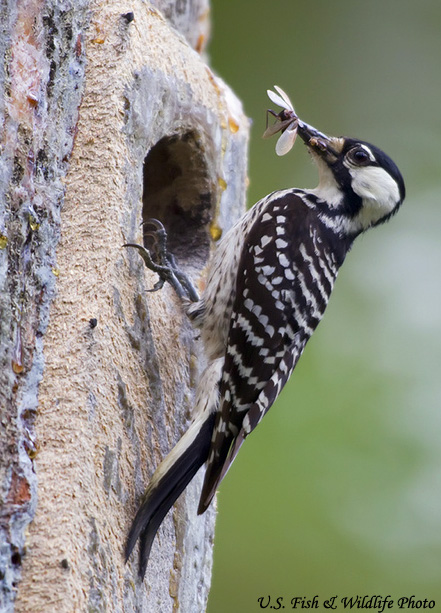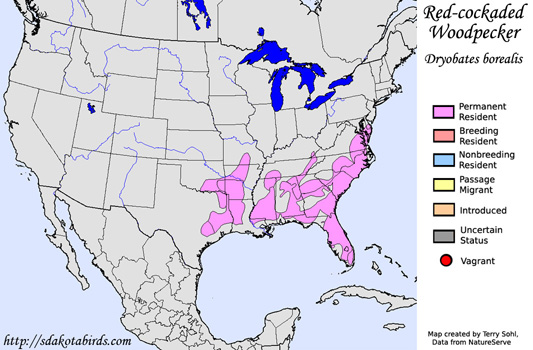| Length: 8.5 inches | Wingspan: 14 inches | Seasonality: Non-resident in South Dakota |
| ID Keys: Black-and-white barring on back, white underparts with spotted flanks, white face with dark malar stripe and black cap and forehead | ||
 The
Red-cockaded Woodpeckers is a specialist of mature pine forests of the
southeastern United States. They have picky habitat requirements,
preferring old-growth pine forests where the trees are old enough to be
affected by "red heart" disease, a fungal attack that softens the core of
pine trees and makes excavation of nest holes easier for the woodpeckers.
With the large-scale clearing and commercial forestry of the southeastern
United States, Red-cockaded Woodpeckers declined dramatically in the 19th
and 20th centuries. The current emphasis on commercial forestry in
much of the home range of the Red-cocakded Woodpecker has result in
large-scale conversion of "natural" forest ecosystems with loblolly pine
plantations, with cutting cycles as short as 15 to 20 years. As a
result, trees don't mature enough to be affected by red-heart disease, and
are thus unsuitable for nesting by the Red-cockaded Woodpecker.
Conservation efforts in the southeast have focused on maintaining stands of
suitably aged nesting trees, offering artificial nesting cavities, and using
controlled burns to maintain an open understory. Populations are still
scattered and local, but conservation efforts have resulted in increases in
overall populations in recent years.
The
Red-cockaded Woodpeckers is a specialist of mature pine forests of the
southeastern United States. They have picky habitat requirements,
preferring old-growth pine forests where the trees are old enough to be
affected by "red heart" disease, a fungal attack that softens the core of
pine trees and makes excavation of nest holes easier for the woodpeckers.
With the large-scale clearing and commercial forestry of the southeastern
United States, Red-cockaded Woodpeckers declined dramatically in the 19th
and 20th centuries. The current emphasis on commercial forestry in
much of the home range of the Red-cocakded Woodpecker has result in
large-scale conversion of "natural" forest ecosystems with loblolly pine
plantations, with cutting cycles as short as 15 to 20 years. As a
result, trees don't mature enough to be affected by red-heart disease, and
are thus unsuitable for nesting by the Red-cockaded Woodpecker.
Conservation efforts in the southeast have focused on maintaining stands of
suitably aged nesting trees, offering artificial nesting cavities, and using
controlled burns to maintain an open understory. Populations are still
scattered and local, but conservation efforts have resulted in increases in
overall populations in recent years.
Habitat: Found most often in mature pine forest, with trees of sufficient age and size for nesting. Prefers longleaf pine forests with periodically burned and open understories, but will also use other types of pine forest.
Diet: Feeds heavily on insects, but also occasionally eats fruits, berries, and pine seeds.
Behavior: Forages by moving about on the trunks and large branches of pine trees, flaking bark off in search of insects.
Nesting: The Red-cockaded Woodpecker strongly prefers nesting in old, large pine trees that have been infected with "red heart disease", a fungus that results in a softer woody interior that is more easily excavated. The female usually lays 3 to 4 eggs in the nesting cavity, and both the male and female help to incubate the eggs. "Helper" birds within the larger family group also may sometimes help to incubate the eggs. After the young hatch, they are fed and cared for by both parents as well as helpers.
Song: Has a variety of contact calls and rattling calls, often heard in family groups of Red-cockaded Woodpeckers. Drumming is heard much less frequently, and is typically relatively quiet compared to some woodpecker species.
Migration: Considered a permanent resident throughout its range.
Interactive eBird Map: Click here to access an interactive eBird map of Red-cockaded Woodpecker sightings
Similar Species: In range, most similar in appearance to Hairy Woodpecker or Downy Woodpecker, but barring on back easily distinguishes Red-cockaded Woodpecker from those species.
Conservation Status: Populations remain small and fragmented, and vulnerable to continued landscape disturbance and loss of suitable nesting habitat. However, with conservation efforts, populations have been increasing in recent decades. For the time being, the IUCN still lists the Red-cockaded Woodpecker as a "Vulnerable" species.
Further Information: 1) U.S. Fish & Wildlife Species Profile - Red-cockaded Woodpecker
2) Audubon Guide - Red-cockaded Woodpecker
3) USGS Bird Infocenter - Red-cockaded Woodpecker
Photo Information: Photo by U.S. Fish and Wildlife (Public Domain)
| Click below for a higher-resolution map |
 |
| South Dakota Status: Non-resident in South Dakota |
Additional Red-cockaded Woodpecker Photos (coming soon!!)
